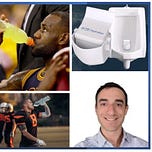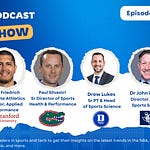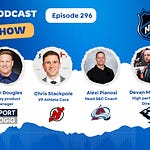This week, we have the honor to interview Michael Bender, CEO, Intake Health, a health tech company building health toilet technology.
Intake Health is on a mission to match healthspans with lifespans. They are the leader in turning toilets into health and wellness monitoring devices that passively surface critical health and wellness data instantly. This data empowers individuals to make informed decisions, allows for proactive coaching, and can be sent directly to physicians. Intake Health’s first commercial product, InFlow, turns urinals into hydration testing health toilets. Additional technology, funded by the National Science Foundation and National Institutes of health, will surface detailed dietary intake, early indications of disease, and medication adherence information.
Here is a video explaining how the technology works:
Intake Health partners with stakeholders across sports, tactical, and workplace safety organizations. In less than a year, their hydration testing product, InFlow, has been adopted by 31% of the top five US pro sports leagues such as the NHL, MLB, MLS, NBA, and NFL, over 30 collegiate programs, and other leagues like the Premier League.
📝Show Notes: Through this interview, we touched on his background, his company and product, the benefits for sports organizations and athletes to use his product. We also talked about their competitive advantage, business model and plans for the next 12 months.
Best Quotes: Here’s some of the key discussion points and best quotes from our conversation with Michael:
On his background:
“I was trained as an electrical and computer engineer, but I have always been an entrepreneur. I gravitated more towards the software side of things. I always thought that was pretty interesting that with just your computer, you could create so much value for people. So I started software companies throughout college. I went and worked for a small one upon graduating. The leadership team was amazing and I was fortunate to be able to join them and play a role in growing and selling that company a couple times”.
“I created another software company after that where we were leveraging cloud computing. We partnered with FOX, NBC, ABC, CBS and other networks to make high volume short term flash sales easy to execute on television segments. After running that business for 10 years, I got into Intake Health. Intake Health is the third company that I started and my brother actually reached out to me for this one. He's a biomedical PhD engineer, so combined with my history of entrepreneurship, software technology, and electrical engineering - it made for a great founding team. So we teamed up to find a way to help match healthspans to lifespans”.
On his company Intake Health, and how he got funded initially:
“We started around 2017. We've mostly been funded by government grants today. So we've won a handful of grants from the National Science Foundation and the National Institutes of Health, which funded the development”.
“And we take a lot of pride in the level of scrutiny and the scientific method that we are using when we're developing our products. We started down a medical path in being able to detect different health indications from the toilet. Along our journey, we encountered coach Darl Bauer over at the University of Houston who asked us if we could measure hydration for his football team”.
“And so after interviewing a handful of teams, we realized that there was a pressing need in elite sports and the sports world for better hydration testing. So we pivoted our direction to create a product specifically for sports teams to measure hydration in the locker room”.
On his first hydration assessment product Inflow:
“InFlow is our first commercial product. As athletes are using the locker room, using the restroom, it gives them instant feedback. That's very easy to understand. It flashes green, yellow, or red at you, depending on your hydration status. So every time you're going to the bathroom, we're bringing hydration, top of mind, hydration awareness, in a fun way that's also creating accountability amongst the team and amongst the coaches. A recent customer survey reports that over 90% of our customers believe their teams are more consistently hydrated after deploying InFlow”.
On the fact that their product is not measuring data on athletes but is empowering them with the information provided:
“It's not a connected device. We're not sending personal information anywhere. We're not aggregating data, which I think brings a lot of trust to the product. You can measure quite a bit of stuff from urine, not just hydration. However, InFlow only measures hydration and only does it at the device. And so our goal was really to empower athletes with the information that they need to be successful.”
On the fact that their product is used by 31% of the top five US pro sports leagues (MLS, NFL..):
“We're in 31% of the top five US pro sports leagues at this point and we are in quite a few D1 universities. And what our customers are telling us is that InFlow is doing what it's supposed to do, bring about consistent hydration awareness that is driving hydration behavior change.”
“I’m to understand that it’s hard to get a product into the team environment during the season. But, it’s exciting to see such quick adoption of InFlow. We’ve been able to reach all these customers in less than a year.”
On how teams are currently measuring hydration by taking urine samples which can be time consuming and does not provide instant feedback:
“Most teams, if they can afford the resources, are already doing something related to hydration (…) We've heard that, at most, teams measure hydration levels as much as once or twice a week during camps, where they're collecting urine samples from all the athletes. But allocating resources for frequent testing during the season is generally not possible”.
“A staff member has to then go take those urine samples and test them generally with what's called a refractometer, where you take a bit of the urine, you put it into a device. There are optical ones, there are digital ones, but you have to transfer urine to a device, read the value out, write that down, and generally you have to clean the device and do the next sample”.
“And what's hard about existing solutions is one, certainly the resources of the staff can be spent doing something better arguably than measuring urine samples if that's even an option. And two, now the output is certainly useful information, but using these existing processes tends to get results to the athlete too late to act in a meaningful way”.
On how teams are using their hydration assessment device in conjunction of their existing processes to monitor' athletes’ hydration level:
“Teams are using our technology either in conjunction with those processes or in some cases after deploying our technology, they're saving time and just not using the existing processes anymore because obviously now when athletes are going to the bathroom where they would be anyways to collect that sample, they're getting that result in real time and then acting accordingly”.
“Trainers are saying, Hey, if you get a red or a yellow, come talk to me. And athletes are actively engaging trainers and dieticians with their results coming in saying, Hey, I'm getting yellows and reds. What can I do to improve my hydration status? And then it's bright enough even in the locker room that athletes are helping with that as well. Like your teammates want you to also be hydrated so that you can perform at your top levels, and so they're holding each other accountable”.
On what teams like the most about their product such as the ease of use and the instant feedback they are getting on athletes’ hydration level.
“I think what teams like the most is just how easy it is and how it is hands free, and it's solving a problem they already know they have. They're telling us “we have fridges right outside the locker room. Right? And they see those drinks dwindling faster than they were before. They see guys coming out of the locker room, grabbing a drink where they wouldn't before”.
“And so they see that it's working and compared to collecting maybe 120 urine samples and testing those on a regular basis. They don't have to do that anymore. InFlow gives you unlimited hydration testing”.
“So once InFlow’s installed, it's there, it's rechargeable. You do have to take a component out, clean it, and recharge it, but it's designed to last 4,000 tests before a recharge, which depending on your configuration and how you have InFlows deployed, could be anywhere from maybe three weeks to two or three months between charges. So it's pretty darn low maintenance, especially when compared to trying to execute hydration tests every time the athlete goes to the urinal with current options”.
On their competitive advantages and how it is complementary to other hydration assessment solutions:
“I honestly think that our product pairs well with other kinds of hydration testing solutions (hydration patches..). If you're putting on a patch or something, it's complimentary. You can figure out with some of those other technologies during the game and during practice, how a player responds and performs”.
“But it's too late at that point to actually do any kind of proactive remediation. You can't fix the problem yet if you're out there playing, you’re kind of just learning your behaviors. What our product does is keep hydration top of mind, so every time you're going to the bathroom you are getting the awareness. You have so much going on in your day, hydration isn’t usually top of mind. InFlow changes that.”.
“Our device definitely trains you, it teaches you your behaviors and your patterns and then consistently keeps you aware of that and keeps you accountable on an ongoing basis. Compared to what people are doing for hydration testing and checking today, other solutions have their pros and cons, the refractometry, the dipstick, etc, but none can be as pervasive as InFlow without a ton of resources”.
On their business model and pricing model:
“So again, it's a rechargeable device. It is a one time fee. You can buy the product, we sell it in four packs. It costs $2,599 per four pack. You can buy it on our website or you can call us. We also sell it through distributors, so you can contact your favorite distributor and see if they carry the product as well”.
“We do have a one year warranty on the product also. I think if you talk to any of our customers, I'm hopeful they'll tell you that they really appreciate working with us and appreciate our customer service. We're not going to nickel and dime you over the warranty, we know it’s new technology.”
On their plans for the next 12 months:
“In the next 12 months we're definitely going to continue to prioritize the world of elite sports. And one thing that we've talked a lot about is that InFlow goes in the urinal. You haven't asked the question that many do, which is how do we support the other half of the population?
“And so female athletic teams can use the product today, it's still more convenient than what you would be doing otherwise. You can put InFlow in a configuration where, as a female, you still have to collect a urine sample, but you can then pour it through InFlow and get your instant hydration result, which again is better than somebody else having to do that and give you results late.”
“But it's not a parity experience. And so we're really focused on bringing a product to market that is native to the toilet environment instead of the urinal environment. So basically bringing the same InFlow hydration experience to the toilet is the next product we plan to release. And then we have some other health and wellness related data collection technology in the works, but I don't think that will be within the next 12 months”.
“Right now we have the flywheel going, so we're operating profitably. While we're not actively seeking funds at the moment, raising equity backed capital is certainly not off the table. We’ll likely need cash to grow faster that revenue affords at some point in the near future, but it’s not required, which is a nice spot to be in as a young business”.
You may also like:
🔥 Upside Chat: Dave Hancock, CEO, Apollo (Leading Athlete Management Systems (AMS) vendor)
🔥 Upside Chat: Dr Andy Barr, Consultant, Brooklyn Nets (NBA) & Quantum Performance Founder
🔥 Upside Chat: Ismael Fernandez, ThermoHuman CEO
🔥Upside: AMS Ecosystem Analysis: Key Trends, Vendors and Recommendations to Teams
💦Upside Analysis: The sweat and heat sensing market (Key Trends, Vendors)












